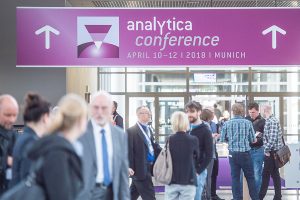Last week, the team took a trip to Munich for Analytica 2018. The conference is one of the key events of the analytical calendar and brings together users, manufacturers and researchers for knowledge sharing and direct exchange between science and industry. More than 1,200 exhibitors and 35,000 visitors from around the world attended this year’s show, with topics spanning the broad range of modern industrial and scientific analysis.
 Analytica has a clear focus on laboratory solutions for industry and research, and provides its exhibitors and visitors with a comprehensive market overview, showcasing the entire value chain in the laboratory. The 2018 show was also a celebration of Analytica’s 50th anniversary from the inaugural event in 1968, which attracted 4,000 visitors from 17 countries. It is clear how far it has grown since then.
Analytica has a clear focus on laboratory solutions for industry and research, and provides its exhibitors and visitors with a comprehensive market overview, showcasing the entire value chain in the laboratory. The 2018 show was also a celebration of Analytica’s 50th anniversary from the inaugural event in 1968, which attracted 4,000 visitors from 17 countries. It is clear how far it has grown since then.
It’s always a busy show, but we were impressed by the size of the event this year, as well as the buzz that was apparent across exhibitors and delegates alike.
As reported in our blog earlier this year, the analytical instruments market has been forecast to thrive in 2018, and this was very much in evidence last week. Key industry players demonstrated the ways in which they are pushing the boundaries of innovation across a number of applications, including pharmaceuticals, chemicals, biotechnology, food, and environmental, among others.

One of the key trends coming from this year’s event was smart laboratories. Several companies unveiled new software solutions that allow devices to be linked and controlled from anywhere, meaning that, in future, smartphones will be able to show real-time data for experiments, allowing scientists to check progress and monitor parameters throughout.
It has the potential to be truly revolutionary as, for example, if the parameters are correct, then it is not necessary for a technician to be present in the laboratory. If problems do arise, the systems are able to send a warning, therefore simplifying operation and freeing up precious resource.
Examples of such work being facilitated in and out of the field include that of environmental analysis. Analysts now have the ability to utilise a mobile instrument to detect methane and other soil gases, due to the GPS module to automatically assign the correct location to the data.
Other key items on the agenda at Analytica included:
-
- Imaging – Devices that combine various measurement methods, with Raman imaging in particular remaining an increasingly popular technique in this way. Some of the technology included techniques based on chemical analysis by Raman spectroscopy with optical information from microscopy, for example.
-
- Pollutant Detection – The ability to detect unknown pollutants, instead of measuring already regulated substances – a goal that food and environmental analysts are increasingly pursuing. An example of chemicals that are currently attracting much attention in these markets is poly- and perfluorinated compounds. They are found in disposable coffee mugs as well as in fire-extinguishing agents and many other products.
-
- Cannabis – The growth of the cannabis market remains a key area to explore – you may remember our recent blog on this topic, as part of our British Science Week activity. Many more companies are entering this market with different solutions for how to maintain quality assurance (in areas such as potency and purity) as it is being legalised both medicinally and for recreational purposes in an increasing number of countries.
With so many exciting areas developing and offering opportunity for analytical scientists, it’s clear to see why Analytica is such an important date in the industry’s diary, and just why it draws in so many of the top companies, as well as increasing numbers of delegates year-on-year.
Exhibiting at a trade show can be a significant investment, especially for smaller businesses, but when done successfully, it can prove to be incredibly valuable. Get in touch if you need help with your next trade show.
By Scott Girling-Heathcote, Account Manager at The Scott Partnership.





